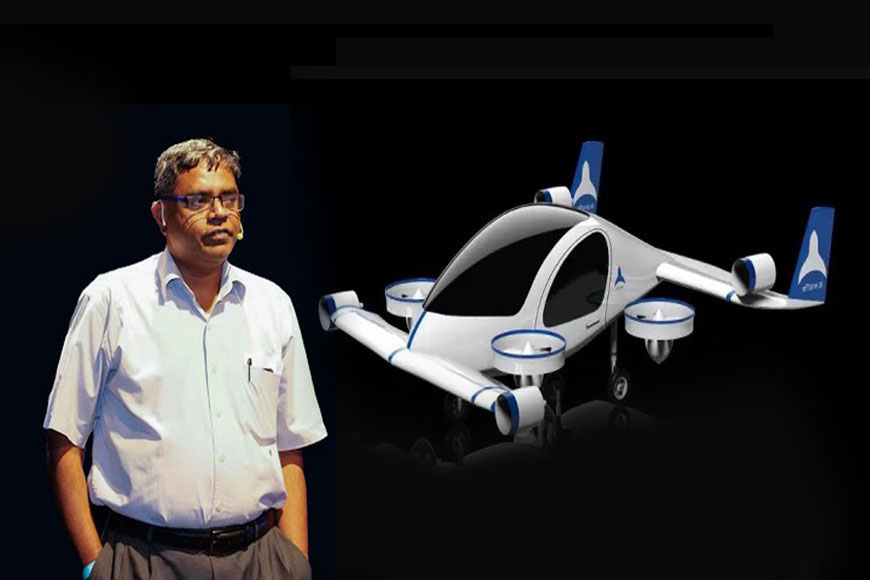The man behind India’s first e-flying taxi—GetBengal story

If dreams had wings, they would fly, and for centuries, humans have yearned to fly in different formats. With the advancement of technology and the desire to cut down on pollution caused by fossil fuels, scientists have been experimenting with everything starting with an ‘E.’ From battery-operated cars to autos, to drones, and now in India, ePlanes are making their debut. These ePlanes, metaphorically named Flying E-Taxis, have been introduced as a futuristic alternative to traditional modes of transport. The man behind the launch of India’s first flying taxi is again a Bengali professor, Satya Chakravarthy, the founder of ePlane Company, and a distinguished professor of Aerospace Engineering at the Indian Institute of Technology, Madras. This groundbreaking invention of the e200, as the flying taxi is named, has brought India to the forefront of the world’s alternative transport and transit system.
This development is a futuristic, jet-set step into the future where pollution needs to be curbed, yet the global transport network needs to be widened to bring every country nearer to the next. Keeping this dream alive through technological advancement worldwide, Professor Satya Chakravarthy founded ‘ePlane Company.’ Prof Chakravarthy has addressed various aspects of the e200’s design, safety, regulatory considerations, and its potential impact on urban transportation in a recent media interview. When asked about the mission behind the project, Prof Chakravarthy explained: “The project embarked on a mission to overcome significant technical and logistical challenges to realise a compact, efficient aircraft capable of navigating the complexities of India’s bustling urban landscapes. We had to make the aircraft very compact so that we could land in tight spaces, fly over crowded skies in India. We want to cover short distances multiple times before we have downtime for charging the battery.”
The e-aircraft runs on batteries and hence does not use fossil fuels, which are not just expensive but also cause immense air pollution. India’s skies have become extremely busy with multiple airlines connecting the world and different cities of the country. There have even been instances where the airport was so crowded that one had to wait for hours before takeoff. Despite formidable hurdles, ePlane has achieved significant milestones, including successful test flights of a subscale prototype, the e50. Professor Chakravarthy is hopeful that the maiden flight in October-November will mark a historic moment in India’s aviation history.
Ensuring passenger safety is crucial for making such a breakthrough invention popular. The natural question that arises is how risky these flights operated on batteries would be. What happens if the flight needs to keep hovering in the sky due to unforeseen climate concerns or a technical snag? What happens if the battery charge is gone? ePlane, in a media release, mentioned that passenger safety was of paramount priority. They have a multifaceted safety strategy designed to mitigate potential risks and they rigorously adhere to strict international standards. As Prof Chakravarthy assured: “Failure rates will range from 1 in 10 million to 1 in a billion across various components and subsystems.” The aircraft is designed in such a manner that it will be able to withstand extreme weather conditions and potential failures.
So what are the detailed safety features of e200? It has multiple layers of redundancy, including emergency measures such as parachutes and inflatables, to ensure a soft landing in the event of an emergency. It is aimed at safeguarding passengers in diverse scenarios. There are also vertical rotors and aerodynamic design principles to enhance stability and control during flight. What happens if critical machinery components fail? He explained: “The redundancy is built into the design, whereby both the wings and vertical rotors can independently support the aircraft’s weight, providing additional layers of safety in case of emergencies. By meticulously addressing potential failure scenarios and implementing robust safety measures, ePlane aims to instil confidence in passengers and regulatory authorities alike, ensuring the utmost safety and reliability of its flying taxi service.”
Though the safety concerns of this e-aircraft have been duly addressed, another unimaginable challenge is how to navigate through the already crowded Indian skies. There are potential operational restrictions in congested urban areas of India, and hence, mapping needs to be done with a phased approach to expand operations based on safety performance and regulatory compliance. But ask the common man, and they will still be in awe of the futuristic model of these flying taxis. They will undoubtedly come at a premium cost and not suit the pockets of the budget air passenger. But as per the IIT professor, affordability and accessibility are pivotal factors taken into consideration while adopting ePlane taxis on a larger scale. Professor Chakravarthy is ready to offer services at just double the fare of traditional ride-hailing services like Uber, promising significant time savings for passengers.
e200 can even have a sizable international market as it is far more affordable and can be conveniently operated compared to other international brands, although the international regulatory challenges are far more stringent than in India. As he mentioned: “We can cut the international competition in terms of cost. But, in aerospace, we will have this problem of ‘Not Invented Here Syndrome’. There is national-level protectionism that happens in aerospace…. (and because of foreign regulations for flying) their citizens will actually be deprived of the benefit of a lower-cost offering that we will have.”
Chakravarthy is ready to collaborate with international organisations for computational fluid dynamics or finite element analysis, manufacturing partners, and software developers, as well as for infrastructure-related partnerships for operational excellence that include real estate or landing site maintenance organisations and charging infrastructure. This is because the project plans to utilise existing helipads, followed by expanding to locations such as parking lots, metro station rooftops, and large building rooftops, including offices and apartments, to facilitate take-off and landing in public and private spaces. Chakravarthy stressed the importance of establishing multiple landing sites across urban areas to ensure accessibility and meet demand effectively.
e200 is hope for a brighter future, and once again, a Bengali brain is behind this new era of urban mobility.












